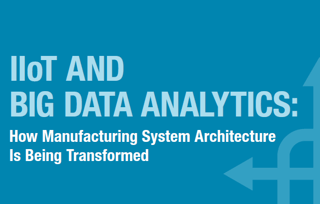 On Wednesday, August 24, LNS Research hosted the webcast, “Revolutionize Your Manufacturing System Architecture with IIoT and Big Data.” The presentation focused on a Digital Transformation Framework to evolve your manufacturing system architecture to connect people and things across the value chain. The presentation also provided a roadmap to capture the onslaught of Big Data, effectively manage it, and build a business case that specifically addresses your organization’s strategic objectives and Operational Excellence maturity.
On Wednesday, August 24, LNS Research hosted the webcast, “Revolutionize Your Manufacturing System Architecture with IIoT and Big Data.” The presentation focused on a Digital Transformation Framework to evolve your manufacturing system architecture to connect people and things across the value chain. The presentation also provided a roadmap to capture the onslaught of Big Data, effectively manage it, and build a business case that specifically addresses your organization’s strategic objectives and Operational Excellence maturity.
Here are the most-asked questions we received during the presentation.
Click here to speak to Matthew
Q1.Which industries are showing the most progress in IIoT adoption and maturity?
A1. For the most part, we are seeing about the same level of maturity (early adopter) across process, discrete, and batch industries. Each industry, however, has its own specific use case driving adoption. It could be Smart Connected Assets in industrial equipment, the connected mine, smart grid, etc. The key is to clearly identify these strategic objectives for your company and industry, and support with a cross-functional team and the right technology infrastructure.
Q2. How much influence should each localized staff really have in the initiative?
A2. Always focus on the customer, and incorporate the customer to the maximum possible extent. In many cases, Industrial Internet of Things (IIoT) projects are going to directly impact the nature of work in manufacturing; how employees collaborate, share information, maintain and operate equipment, and make decisions. If representatives of the people doing the work aren’t included in decision making, IIoT projects will just be another contributor to the long list of failed technology projects at industrial companies.
Q3. What is standing in the way of coordinating access to machines?
A3. Culture, fear, and security – not technology. This means the change won’t be immediate, but instead it will be slow, 5 – 10 years. Plus, companies need to match adoption to culture and push to change culture, but change can only happen so fast.
Q4. Is there a difference between German and U.S. approach?
A4. There are more similarities than differences, but here is a thought on the differences at the great risk of over-generalizing. Terminology is different: smart manufacturing vs. Industrie4.0. The German approach is more automation centric and interested in driving intelligence towards autonomous machines. The U.S. approach is more information centric and focused on driving new insights from machines. Also, as with many things, Germans are more concerned with privacy and security than Americans.
Q5. Is there any International committee or standard for IIoT?
A5. There are a number of them. The one that has the most momentum today is the IIC: Industrial Internet Consortium. The IIC is pretty technical and focused on test beds. A number of vendors also run consortiums, as do a number of countries like the US with Smart Manufacturing Leadership Coalition and Germany with Industrie4.0.
Q6. Do you really see plant networks opening up and, with MES systems in place, what’s the compelling reason to further connect devices - especially via cellular or wifi?
A6. I do see these networks opening up. I believe it will be a slow process, 10+ years. Companies will start by moving some data to the Cloud for information sharing, benchmarking, and providing global visibility and analytics that can't be provided with local systems. Cloud-based control is a (long) ways off, culturally not technically.
Q7. What will be the right strategy for a machine builder?
A.7 This is a broad question with many nuances that can't be addressed, but the general trend is towards providing Smart Connected Assets that can deliver added benefits and services to customers and enable long term business model changes.
Q8. What are the best examples of Machine Learning you have seen in the industry so far? How mature do you think this technology is?
A8. The technology is fairly mature, having been developed many years ago by stalwarts of the tech industry: think Google and Facebook. However, it is new to the industrial sector, but we are already seeing compelling examples such as:
- Identify theft from utilities
- Improving fuel efficiency of rail
- Connecting and improving up time of robotics
- Remote mining
If you have any more questions please feel free to contact me here, or watch it on-demand now for anything you may have missed!